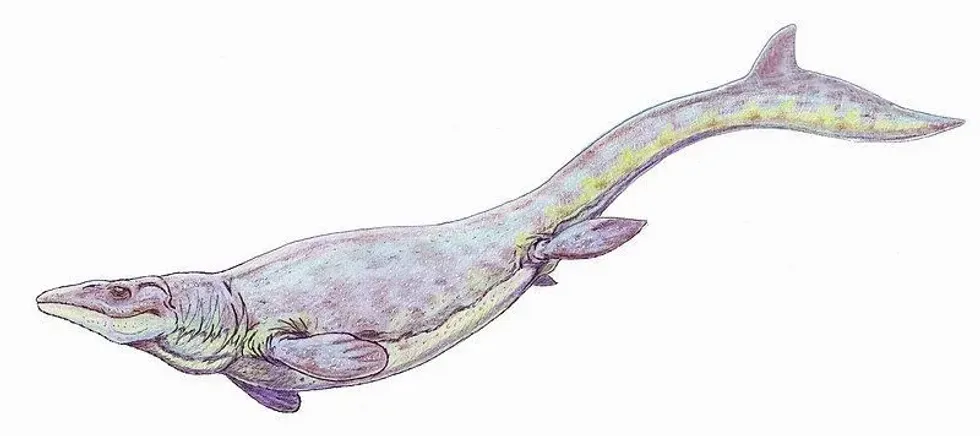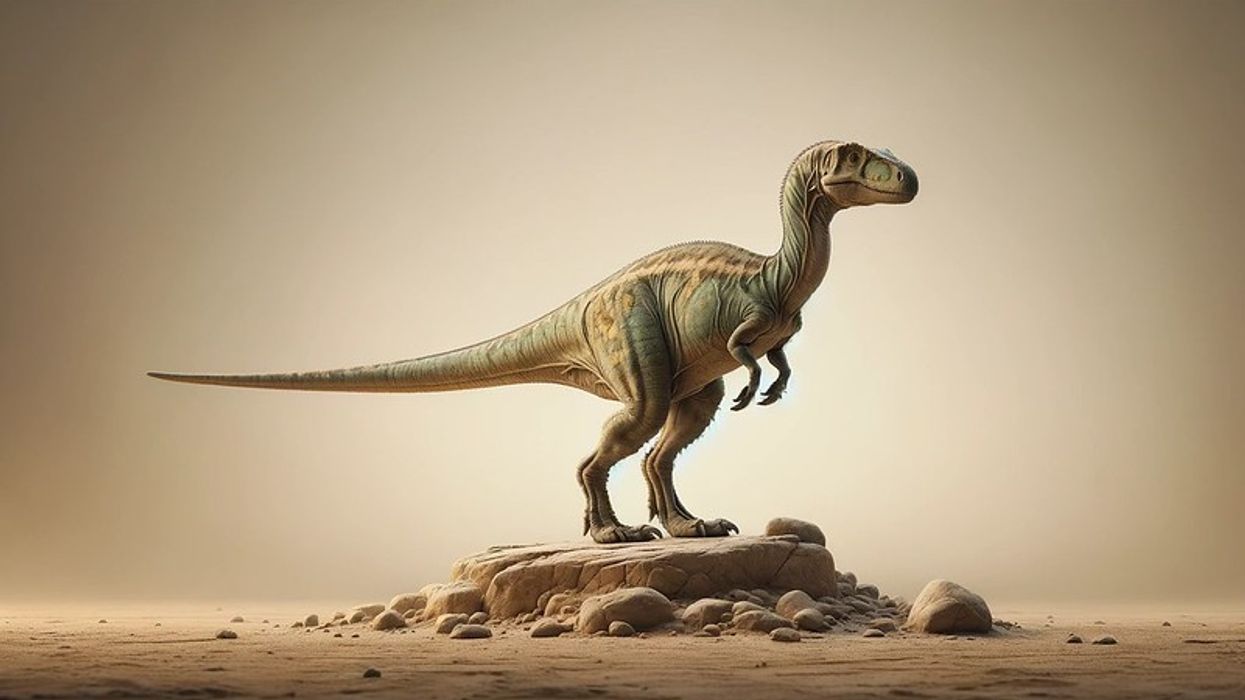Globidens is a group of extinct lizard species that belongs to the tribe Globidensini of the Mosasauroidea superfamily, the family Mosasauridae, from the Late or Upper Cretaceous period. The name Globidens was described by Charles W. Gilmore in 1912.
In the publication of 2012 by Gilmore Charles, the first species of Globidens was described as Globidens alabamaensis. This species is also a type specimen of this genus.
The species and genus were classified based on incomplete skeletal remains of the specimen with a partial skull consisting of a number of teeth, several fragments, and a single cervical vertebra. The fossil evidence of this animal also shows that these mosasaurs fed on turtles and ammonites.
A lot more species were defined within this genus, such as Globidens dakotensis, Globidens simplex, Globidens phosphaticus, and Globidens schurmanni (Martin J E). Also, some species assigned to this group have been reassigned.
The tribe Globidisini consists of marine squamates, which are called globidensine mosasaurus or globidensins. Globidens term has two Latin elements, 'globus' means 'globe' and 'dens' means 'teeth.'
This describes one of the characteristics of these species. The term Mosasaurinae is a combination of 'Mosa,' Latin term for Meuse river, and Greek saurus meaning 'lizard.'
If you enjoyed reading these cool facts about the Sinopterus, then make sure to check out these fun facts about the Harpactognathus and Incisivosaurus on Kidadl.
Globidens Interesting Facts
How do you pronounce 'Globidens'?
The pronunciation of the genus Globidens is 'Glo-bih-denz.'
What type of dinosaur was a Globidens?
Globidens is an extinct genus that belongs to the class Reptilia, Mosasauridae family, phylum Chordata, and tribe Globidensini. The genus Globidens name means 'globe teeth' due to the globular-shaped, shell-crushing teeth for a strong bite.
The specific term of the type species Globidens alabanensis is in reference to the location or fossilized site where the fossil evidence of this species was discovered.
The globular and robust teeth of Globidens dinosaurs have usually been compared to [ Plesiotylosaurus ] and [ Prognathodon ] genera. The Globidens fossil evidence is currently an almost complete skeleton.
Some species of this mosasaurs genus are G. alabamaensis (GIlmore, 1912), G. dakotensis (Russell, dale 1975) of central South Dakota site, G. schurmanni (martin, 2007), G. phosphaticus, and G. simplex. In 1975 a new species, G. dakotensis (Russell, 1975) was described by Friedrich von Huene.
More data or records need to be collected of the species G. schurmanni. Globidens taxon species are considered to be related to mosasaur Carinodens with similar characteristics.
It has concurred from the remains that larger mosasaurs might have preyed on this animal and also this species was not a fast swimmer.
The presence of the scleral rings on fossils indicates that this species hunted food at night. This genus of species has the strongest bite compared to other mosasaurs.
In which geological period did the Globidens roam the earth?
Globidens mosasaur fossil evidence that was collected from fossilized sites dates back to the Late or Upper Cretaceous in the Campanian-Maastrichtian of the Cretaceous.
When did the Globidens become extinct?
These mosasaurs probably became extinct in the mass extinction event at the end of the Maastrichtian period.
Where did a Globidens live?
The first discovered specimens were from a site in North America like the West Interior Seaway. The holotype of G. dakotensis was recovered from Africa (Friedrich von Huene). There were also holotypes found in the Middle East, the USA (Museum of Natural History), South America, and the Timor Islands in Indonesia.
What was a Globidens's habitat?
These species of Globidens occupied a range around coastal waters and warm shallow seas.
Who did a Globidens live with?
The data on the lifestyle of these Globidens wildlife species is not available. The species of Globidens probably lived together like the other dinosaurs.
How long did a Globidens live?
The data on the maximum or average lifespan of these creatures is not yet available.
How did they reproduce?
The reproduction of the mosasaurs was oviparous. However, the data breeding process, incubation, and parental care of this mosasaur (Globidens) are not available.
Globidens Fun Facts
What did a Globidens look like?
 We've been unable to source an image of Globidens and have used an image of Prognathodon instead. If you are able to provide us with a royalty-free image of Globidens, we would be happy to credit you. Please contact us at hello@kidadl.com.
We've been unable to source an image of Globidens and have used an image of Prognathodon instead. If you are able to provide us with a royalty-free image of Globidens, we would be happy to credit you. Please contact us at hello@kidadl.com.
The appearance of these mosasaurs (Globidens) species was like all the other mosasaur that is a streamlined body with powerful jaws, flattened tails, and flippers. One of the distinct characteristics was the Globidens teeth, which were globular or rounded rather than sharp teeth like the other mosasaurs.
Globidens tooth would be like a ball hammer striking the shell of their prey. They could do this due to the rounded points on the semispherical teeth.
The Globidens skull was robust and the Globidens (mosasaur) jaw was tightly articulated.
It was also noted that these species had a long snout and skull features were identical to Platecarpus. This animal had a large caudal fin and there were probably no fins on the back.
How many bones did a Globidens have?
The data total number of bones this mosasaur (Globidens) had is not known. There were fragmentary fossils collected like a skull with Globidens jaw fossil, single cervical vertebra, many teeth, and postcranial remains. G. dakotensis' fossilized skull is on display in the Field Museum of Natural History in Chicago.
How did they communicate?
The mode of communication of this species is not known. However, the Alectrosaurus species might have communicated through body language, calls, and songs.
How big was a Globidens?
Globidens were 18-22 ft (5.4-6.7 m ) in length. They were almost twice the size of their relatives, Carinodens that measured up to 11.5 ft (3.5 m).
How fast could a Globidens move?
It is not known how fast this creature was. However, this animal was a predator and might have been agile.
How much did a Globidens weigh?
The weight of Globidens was 992-1322.7 lb (450-600 kg).
What were the male and female names of the species?
There is no specific name given to either female or male Globidens.
What would you call a baby Globidens?
There is no specific name given to the baby Globidens.
What did they eat?
The diet of these species was carnivorous. These species were adapted to feed by crushing shells of hard-shelled food with their strong bite from their sharp teeth. The main diet of these mosasaurs includes shellfish, turtles, ammonites, bivalves, and nautili.
How aggressive were they?
It is unknown how aggressive these mosasaurs were.
Did you know...
There are three more genera, Xenodens, Carinodens, and Igdamanosaurus classified within the tribe Globidensini. Most of these genera have sharp teeth that help them grab slippery and soft prey like cephalopods and fish species. Globidensini belongs to the Mosasaurinae and species of this group are called mosasaurines.
This subfamily has another tribe along with Globidensini that is Mosasaurini. Sometimes a tribe called Prognathodontini has also been considered. Fossil remains of this subfamily have been collected from all the continents but not from South America.
The first of all fossil remains belonging to the Masasauroidea superfamily was collected on the Meuse in a limestone quarry, Maastricht in the year 1764. The order Squamata within which this superfamily is classified consists of snakes and lizards.
These were the main predators of the marine regions in the last 20 million years of the Turonian-Maastrichtian age in the Cretaceous period, as large predators like pliosaurs and ichthyosaurs were already extinct.
How did the Globidens go extinct?
This mosasaur belongs to the subfamily Mosasaurinae classification. All the species within this subfamily became extinct by the end of the Maastrichtian period.
How many teeth did the Globidens have?
The exact number of teeth in mosasaurs is not known.
Here at Kidadl, we have carefully created lots of interesting family-friendly dinosaur facts for everyone to discover! For more relatable content, check out these Heterodontosaurus facts and Zuniceratops facts for kids.
You can even occupy yourself at home by coloring in one of our free printable Globidens coloring pages.









